
The shaman, the lord and the warrior:
anthropomorphic petroglyphs at
Chillihuay, Arequipa, Peru
INTRODUCCIÓN
Chillihuay is the name of an extensive petroglyph complex in the mountainous coastal desert of southern Peru. The complex, actually comprising two separate sites - Chillihuay and San Juan de Chorunga - is located in a rather remote and in a rather inaccessible setting in the valley of the Río Chorunga (also known locally as the Río Grande or the Quebrada [de] Chorunga). This section of the mainly dry river valley with its sparsely covered and uncultivated flat valley floor runs west to meet the Río Ocoña some 7 km further downstream from Chillihuay. From the confluence (near the village of Iquipí) the Río Ocoña runs south for about 58 km before it empties its sporadic waters into the Pacific Ocean. From the valley floor the rock art site itself is clearly visible, as the distinctive red-brown colour of the petroglyph rocks high upon the mountaintop strongly contrasts with the background of dark grey rocks.
My observations in this paper have been triggered by a publication in Rupestreweb by Daniel Chumpitaz Llerena and Maritza Rodriguez Cerrón called “Los Petroglifos de Chillihuay: La imagen antropomorfa (del formativo al período de integración Wari)”. In their paper the authors describe in much (graphic) detail the petroglyphs of three large and menacing anthropomorphic figures, but they also provided much useful (archaeological and environmental) background information. However, in my opinion their illustrations and therefore also their explanations of those anthropomorphic petroglyphs show several flaws regarding a few most relevant details, which may have lead to inconsistent conclusions.
The current paper presents alternative illustrations and analyses of the three petroglyphs based on photographic records and on the literature that I have available. The paper also offers alternative hypotheses regarding their possible origin and meaning. It certainly is not my intention to offer a complete scientific inventory of any rock art site in the Ocoña drainage. I also do not want to pretend that I can offer a complete or a scientific archaeological record for the area. I leave that job to the academic, professional archaeologists.
Historical Background
Actually it is unknown to me who first discovered or
reported the petroglyph site of Chillihuay, as none of the published works
about the site that I have available reveals those facts. Linares Málaga does
not seem to have had knowledge of the site before 1973, as Chillihuay is not
mentioned in his 1973 publication. The Inventario Nacional published by Rainer Hostnig (2003: 45-46) only
mentions the site and simply refers to another publication by Linares Malaga
(1991-1992: 11). Thus, 1991 is possibly the earliest reference to the site. A
year after Hostnig’s publication Linares Málaga
mentions Chillihuay (Distrito de Río
Grande; Provincia de Condesuyos) as Nr. 17 in his list of petroglyph
sites (2004: 30). It seems that until 2004 little is actually known about the
site.
Then, two years later, a brief publication, including
some photographs, in the Revista Perú Explorer (2006) revealed the true
importance of the rock art at Chillihuay. In the same year archaeologist Daniel Chumpitaz Llerena (2006) alerted the scientific world in Rupestreweb Mensajes about the dangers of the rock art deteriorating by natural forces and of being threatened by destructive anthropic
activities (looting and mining). A call by Chumpitaz Llerena in Rupestreweb Mensajes to assist with the recording of the petroglyphs at Chillihuay
followed in 2007, but - to my knowledge - this did not result in the
publication of full survey or an inventory. In 2008 Maritza Rodriguez Cerrón and Daniel Chumpitaz Llerena, presented a brief paper (with four photographs) at the III Simposio Nacional de Arte Rupestre held in the town of Huaraz, Perú,
emphasising once more the importance of the petroglyph site of Chillihuay.
Today the rock art complex is
known to rock art investigators, locals and officials. Inevitably, some details about Chillihuay and San Juan de Chorunga also were published on
the internet. In seven photographs of petroglyph panels at Chillihuay (and San Juan de
Chorunga?) were published on the internet without providing any further
background information. In 2009 Dr.
Carlos Trujillo Vera published two photos of petroglyph panels at San Juan de
Chorunga, but also the UTM co-ordinates (707900 E and 8238837 N)
that pinpointed the exact location of the San Juan de Chorunga petroglyphs
(which were copied in another web page in 2013).
In 2014 a ‘video’ with
only rather blurred (but still informative) photos about the rock art of San
Juan de Chorunga was published on YouTube (also
copying the data once provided by Trujillo Vera). Finally, also in 2014, Daniel Chumpitaz Llerena and Maritza Rodriguez Cerrón published a paper on the internet (also providing the correct UTM co-ordinates
for the complex) in which they discussed three impressive anthropomorphic
petroglyphs of the complex. Their 2014-paper probably is the same as their ‘ponencia’ with
the same title, which was presented at the V SINAR - “Eloy Linares Málaga” in the Museo de Arqueología y Antropología, Universidad Nacional Mayor de San Marcos, Lima,
Perú (Chumpitaz Llerena and Rodriguez Cerrón 2013).
Moreover, today Chillihuay is indicated by a large, blue INC
sign that is clearly visible from the dirt road on the alluvial fan of Quebrada
Chillihuay. Also as a most unwanted consequence of all this publicity, several
panels of this hard to reach, sacred site have already been damaged and
violated by vandalism.
In the years after the first
publication on the internet I described and illustrated a number of specific
MSC-Style (Formative Period) petroglyphs and several gender-related and
death-related images from Chillihuay and San Juan de Chorunga (Van Hoek 2011,
2012 and 2013). However, I must emphasise here that I never visited Chillihuay
myself. All my observations (concerning Chillihuay) in my three books - and
also in the current paper - are based on the personal photographic records of
Rainer Hostnig (2008: pers. comm.) and other sources
that I have available (mentioned in this paper). However, only I am responsible
for all my illustrations, observations, conclusions and theories presented in
this paper (and, of course, in my earlier publications).
Notwithstanding criticism (2014) by Peruvian archaeologist Daniel
Castillo Benites (concerning my Simbal paper in Rupestreweb; Spanish translation available as PDF) in this respect, I find it scientifically acceptable (read
the reply by me - in English and Spanish) to use
photographs made by others in order to present a more complete or a different
picture (literally and metaphorically) of certain rock art images or rock art
sites without having visited the site(s) myself. The fact that I am not an
academic, professional archaeologist is completely irrelevant in this
respect. It is the result (the published text and illustrations) that counts;
not so much the path that is followed to reach the result.
However, there is no doubt at
all that I enormously value the scientific data gained by academic,
professional archaeologists. But also their published work (whether
textual or graphical) must be correct and also their findings and
hypotheses can be questioned by anyone. When incorrect (graphical) material is
published, it is too often taken for granted and thus it will be used and
reproduced as if it is correct (for an
example of a clearly incorrect illustration see the drawing by Eloy Linares
Málaga published in my video about the Cerro
Negro rock art site, Peru (Video Fig. 5; also published as Fig. 5 in my Cerro
Negro paper in Rupestreweb: 2014). It is
therefore only scientifically correct to rectify published material that is
demonstrably inaccurate. Then it does not matter whether the person who
rectifies the inaccuracies is an academic person or not. Neither does it matter
whether she or he has visited the site in person.
The Site of Chillihuay
It seems that Daniel Chumpitaz Llerena (2006) at first reported only one petroglyph site
in the area, which he called Chillihuay, while later Chumpitaz Llerena and Rodriguez Cerrón (2008) reported two petroglyph
sites on the slopes of the same hill. They labelled the two sites Chillihuay 1
and Chillihuay 2. Much later a third petroglyph site in the valley was reported
by the same authors (2014). They called it La Jarana;
a site located some 4 km further west in Churunga on
the higher slopes of Cerro Iquipí or Cerro Jarana (see
Figure 1). At the base of Cerro Iquipí is also the archaeological site of La Jarana (PE-BAA3431) with the ruins of
a large number of ancient structures and (unfortunately) looted tombs. Sadly,
similarly looted tombs, with human
remains disrespectfully scattered around, are found at the foot of Cerro
Chillihuay just east of the alluvial fan of Quebrada Chillihuay (Rainer Hostnig
2008: pers. comm.).
It is unknown to me how many images have been
manufactured at the two Chillihuay sites. Rainer Hostnig photographed a total
of at least 76 boulders/panels at Chillihuay in 2008, including several panels
with only one or a few petroglyphs, but it is certain and understandable that
he did not photograph every petroglyph panel. Confusingly, in 2006 Chumpitaz Llerena speaks of more than 5000 panels with petroglyphs (más de 5 mil paneles),
while in 2009 he speaks of more than 5000 images (más de 5 mil grabados).
Whatever he meant, without having available a reliable inventory of Chorunga
rock art I question the number of more than 5000 images. And I definitely have
serious reservations about the number of 5000 panels, even for both sites
combined.
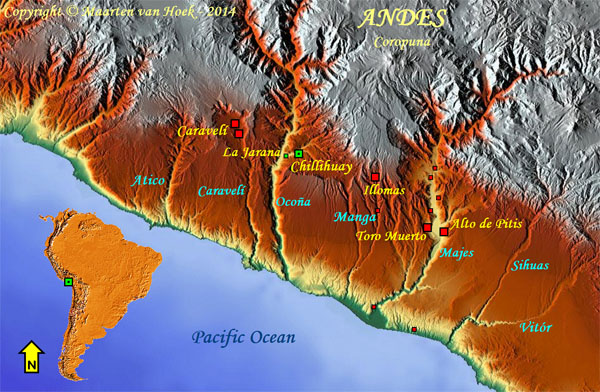 |
Figure
1. Map of a large part of the
Department of Arequipa, southern Peru, with the location
of some relevant
petroglyph sites in that area (all other rock art sites have been omitted).
Drawing © by Maarten van Hoek (2014), based on Google Earth Relief Maps.
|
Moreover, the distinction between boulders and panels
at Chillihuay is troublesome as many petroglyphs clearly have been manufactured
on (often very large) boulders with often several panels, while other panels
are clearly part of outcrop rock. Also important is to realise that most
boulders/panels at both petroglyph sites have not been used for image
production. Unfortunately, up to date no scientific surveys or inventories of
the two sites have been published. For that reason I use the labelling that I
have made for all the rocks/panels at Chillihuay that are known to me.
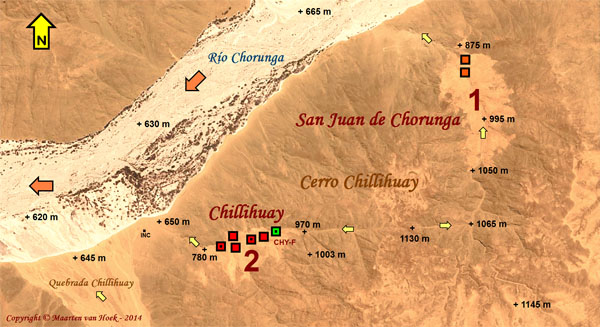 |
Figure 2. Map of the petroglyph
fields at Chillihuay (2) and San Juan de Chorunga (1),
southern Peru. Drawing ©
by Maarten van Hoek (2014), based on Flash
Earth,
Google Earth and on photographs and information by Rainer Hostnig
(2008, 2009 pers. comm.)
and Carlos César Trujillo Vera (2009). However, any
inaccuracy is my responsibility.
|
In addition, in order to avoid confusion I prefer to
speak of the petroglyph site of San Juan de Chorunga (‘Chillihuay 1’ according
to Chumpitaz Llerena and Rodriguez Cerrón) and Chillihuay (‘Chillihuay 2’ according to Chumpitaz Llerena and Rodriguez Cerrón)
(Van Hoek 2011: 38, 2012 and 2013: 29). The map in Figure 2 clearly
distinguishes between the two petroglyph sites on Cerro Chillihuay. They are
about 910 m apart and definitely out of sight of each other. The site of San
Juan de Chorunga is, according to Chumpitaz Llerena and Rodriguez Cerrón (2014), the lesser site with fewer (but often
exceptional) petroglyphs (Van Hoek 2013: Figs 170, 262, 264, 267). Yet the area
with rocks suitable for petroglyph production is larger than Chillihuay; it
measures about 560 m from north to south. However, in this paper I focus on the
site of Chillihuay (2) because the photographic record of Rainer Hostnig only
covered that area.
Chillihuay (2)
Both San Juan de Chorunga (1) and Chillihuay (2) are
located at exceptionally high altitudes and can only be reached by climbing the
extremely steep and gravely slopes of Cerro Chillihuay. The ‘entrance’ to
Chillihuay (at approximately 150 m above the valley floor) overlooks the wide
and north sloping alluvial fan of the Quebrada Chillihuay, the valley of the
Río Chorunga and Cerro Iquipí (summit at 1059 m) 5,7
km to the west (Figure 3). Views to the east, north and south are blocked, but
at several places (glimpses of) the mountainous area to the west can be seen.
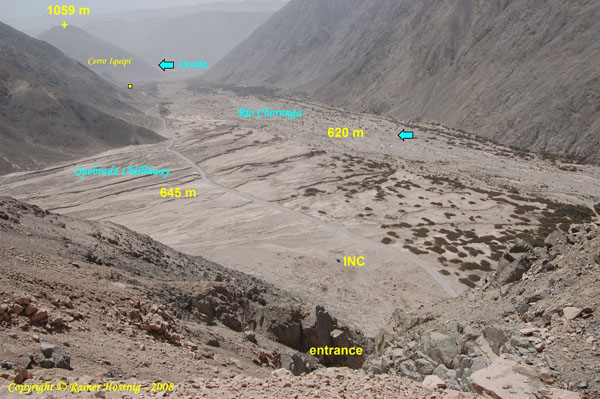 |
Figure
3. View across the valley of
the Río Chorunga, looking west from the entrance of the Chillihuay petroglyph
field, southern Peru. Photograph © by Rainer Hostnig (2008).
The
information on the photo has been added by the author.
|
The petroglyph area of Chillihuay measures roughly 260
m between its west end at 840 m O.D. and its east end at 935 m O.D. (all
altitudes/distances in this paper are based on Google Earth), mainly following
extremely steep and gravely west and north facing slopes and more level dry
valleys. Based on information kindly supplied by Rainer Hostnig (2008, 2009: pers. comm.) and his private photographic collection
generously made available to me, I have divided the Chillihuay petroglyph field
into six Sectors. Sectors A, B and C are located at lower altitudes and are
roughly divided by small dry river valleys (Figure 4). Sector A (the north [SW
facing] slope) has at least 11 boulders/panels (labelled CHY-A-001 to
CHY-A-011); Sector B (the extremely steep south [north facing] slope) has 15
boulders/panels; Sector C (a less steep, north facing slope just east of Sector
B) has 7 boulders/panels. Because of the steep slopes (and possibly also
because of earthquakes) several boulders may have been displaced (sometimes
having fallen on other blocks) and/or have been covered with loose material.
Sectors D, E and F are found at higher altitudes in the
more level dry valleys to the east of Sector A. Because of the more level character of the terrain many
boulders more likely are in situ,
while the outcrop panels are definitely in situ. Sector D (an E-W running dry valley) has at least 32
boulders/panels; Sector E (the NE-SW running branch of a confluence of two dry
valleys) has 6 boulders/panels; Sector F (the E-W running dry valley) has 5
panels. The dry valley, in which Sectors E and F are located, continues further
east until reaching the watershed at 1130 m O.D. (see Figure 4). Then another
dry valley runs east as well and then, at 1065 m, turns sharply to the north
leading to the petroglyph site of (San Juan de) Chorunga further down. It seems
that both sites are easily reached from each other by way of the dry valleys and
no doubt they once were interrelated.
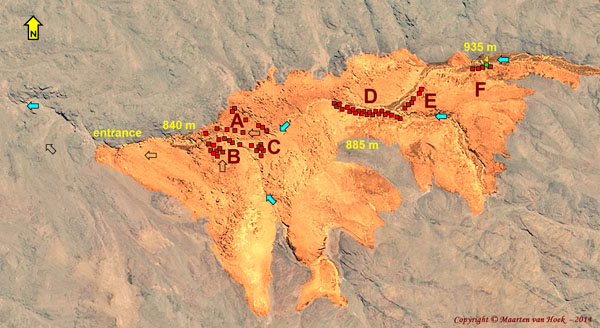 |
Figure
4. Map of the petroglyph field
at Chillihuay, southern Peru. The location of the petroglyph panels
and
boulders that are known to me is only approximated. Drawing © by Maarten van
Hoek (2014),
based on Flash Earth,
Google Earth and on photographs and information by Rainer Hostnig
(2008, 2009 pers. comm.). However, any inaccuracy is my responsibility.
The difference in colour only indicates the two types of stone at the site.
|
Although most petroglyphs at Chillihuay have been
manufactured by pecking the relatively soft volcanic rock with a pointed
(stone) object, there are many instances where especially fine lines have been
incised with a sharper object (like obsidian or a metal tool). Moreover, there
is convincing proof that (some or all?) images have first been pre-scratched
and then pecked, as is evidenced by an anthropomorphic petroglyph on Panel
CHY-D-002 (Figure 5).
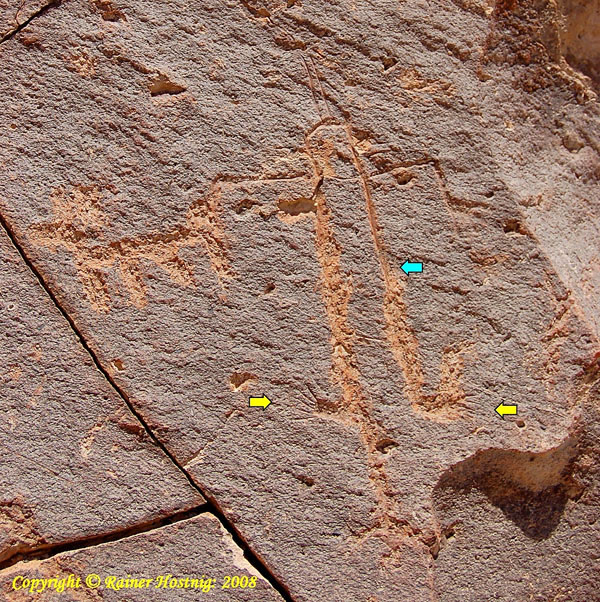 |
Figure
5. Detail of a pre-scratched
petroglyph on panel CHY-D-002 at Chillihuay, southern Peru.
Yellow arrows:
incised lines; blue arrow: incised-pecked limit. Photograph © by Rainer Hostnig
(2008).
The information on the photo has been added by the author.
|
Anthropomorphic Imagery
at Chillihuay
Although many
zoomorphic representations (and relatively few abstract images) occur at
Chillihuay, especially anthropomorphic figures (including all related
petroglyphs such as isolated heads) seem to predominate (these observations are
based on an incomplete record). In this respect Chillihuay differs
significantly from its ‘neighbour’ Toro Muerto (see Figure 1 for location)
where enormous quantities of abstract petroglyphs occur and where zoomorphic
images prevail despite a very large amount of anthropomorphic figures, like the
well-known ‘dancer’ motif, which, as far as I know, seems to be absent in
the petroglyph art of the Ocoña
drainage.
The array of
anthropomorphic imagery is enormously diverse at Chillihuay. It ranges from
small, inconspicuous ‘match-stick’ figures to very large sophisticated and
impressive outlined human figures. Two examples of this latter group of
anthropomorphic images really dominate the scene at Sector CHY-F. Although large (and often highly idiosyncratic)
anthropomorphic petroglyphs occur as well on panels CHY-D-002 (Van Hoek 2013:
Fig. 84), CHY-D-003 (Van Hoek 2012: Fig. 88; 2013: Fig. 92), CHY-D-015B and
CHY-F-001 (Van Hoek 2013: 93), only three petroglyphs have been illustrated and
discussed by Daniel Chumpitaz Llerena and Maritza Rodriguez Cerrón (2014): the Shaman on panel CHY-X-011; the
Lord and the Warrior on panel CHY-F-004. These three anthropomorphic
petroglyphs will be discussed in more detail, taking in account their
(geo)graphical context.
1: The Shaman
The first anthropomorphic
petroglyph that Chumpitaz Llerena and Rodriguez Cerrón describe, depicts a
Feline-Anthropomorph which is found on a panel that has not been photographed
by Rainer Hostnig (2008). As Chumpitaz Llerena and Rodriguez Cerrón (2014) do
not state at which site it this petroglyph is located (San Juan de Chorunga or
Chillihuay), I have labelled this anthropomorphic figure CHY-X-011; the X
referring to a location (at Chillihuay or perhaps at San Juan de Chorunga) that
is unknown to me. As a consequence it is not possible for me to consider this
petroglyph in its spatial context (which would possibly reveal something of its
meaning).
In one of the captions to
their illustrations (2014; unfortunately
all their illustrations are unnumbered) Chumpitaz Llerena and Rodriguez Cerrón refer to
this Feline-Anthropomorph as the Shaman (Shaman)
or the Priest (Sacerdote),
whether this is a correct interpretation or not. For matters of convenience I
will henceforth refer to this petroglyph as the Shaman (realising that all
labels are subjective).
I described the Shaman in an
earlier publication (Van Hoek 2011: 39-40), but at that time I could only base
myself on an imperfect photo that was published in
2007. For that reason the drawing that I made (Van Hoek 2011: Fig. 28) shows
imperfections. The photograph in Chumpitaz Llerena and Rodriguez Cerrón is much better and the drawing that I reproduce here
(Figure 6) is based on their photograph (2014: unnumbered illustration).
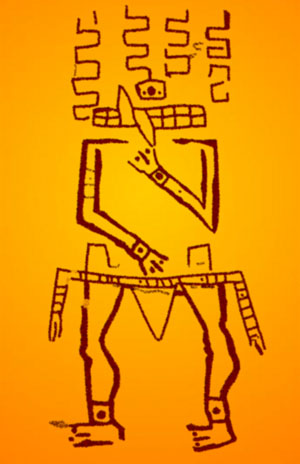 |
Figure
6. Drawing of the Shaman
petroglyph at Chillihuay (or San Juan de Chorunga).
Drawing © by Maarten van
Hoek, based on a photograph by Chumpitaz Llerena and Rodriguez Cerrón (2014:
unnumbered illustration). However, any inaccuracy is still my responsibility.
|
Panel CHY-X-011 features the outlined image of a
frontally depicted anthropomorph - partially damaged - with its relatively thin
arms held against the thorax and abdomen areas. Chumpitaz Llerena and Rodriguez Cerrón (2014) rightly suggest
that the hands of the anthropomorph seem to symbolise the head of a zoomorph,
possibly a snake. A similar feature is visible in a drawing of a petroglyph
reported by Carlos Alberto Paz de Noboa (1940: Croquis 10) on panel
PAJ-008 at Illomas or Pajgchana (see Figure 1 for
location).
The laterally depicted legs of the Shaman distinctly
show knees and calves, while the figure has feet that point to its right.
However, Chumpitaz Llerena and Rodriguez Cerrón (2014) claim that the feet do not symbolise possible
snake’s heads, but in fact their layout is similar to the hands (which in fact
strengthens their hypothesis that the figure is snake-related). Between the
legs is a rather large, outlined triangular shape that may be part of the belt;
a loincloth perhaps. Similarly placed, triangular shapes also occur in
anthropomorphic petroglyphs at Alto de la Guitarra (Van Hoek 2011: Figs 37 and
38) and in a rock painting at Poro Poro or Cerro Udima (Van Hoek
2011: Fig. 44), both in the far north of Peru.
Intriguing is the frontally depicted ‘head’ which is
composed of four rows of meandering, angular lines, that according to Chumpitaz Llerena and Rodriguez Cerrón (2014) represent a headdress (tocado) symbolising the movement of curling snakes (similar
meandering, angular lines indeed representing snakes occur in Majes, for
instance at La Laja). If they are correct, then in fact there is no head (this
will be an important point at the discussion), but equally the meandering lines
may symbolise the head; not a headdress. One of the meanders seems to touch the
mouth, while another seems to end in an element that according to Chumpitaz Llerena and Rodriguez Cerrón (2014) represents an eye. However, I rather interpret this feature as a ‘nose’
because of its centrally placed position and the two small depressions -
flanking a larger depression - that may represent nostrils. This interpretation
contradicts my earlier suggestion (Van Hoek 2011) and now I propose that the
anthropomorphic figure does not seem to have eyes.
The most characteristic feature of the Shaman is,
however, the menacing (closed) ‘mouth’, which shows two vertical rows of
altogether twelve square teeth and two large diagonally placed (interlocking),
pointed fangs. Chumpitaz Llerena and Rodriguez Cerrón (2014) incorrectly call this mouth an agnatic mouth.
The ‘mouth’ only shows teeth (no lips) and clearly the teeth and fangs of the
upper and the lower jaw have been
indicated, while an agnatic mouth is lacking the lower jaw (and teeth). Chumpitaz Llerena and Rodriguez Cerrón moreover relate this mouth to the Chavín tradition (2014: propia de las formas chavines), while that is by no means certain and in my
view highly questionable. I prefer to label the mouth as an MSC-Style element
in which the acronym MSC refers to the possible Manchay, Sechín and/or
Cupisnique (or even purely local) origin of such specific elements as I have
strongly advocated earlier (Van Hoek 2011). The Formative Period Manchay
culture originated in the Lima area of central Peru area and possibly their
imagery once reached Ocoña. It is also possible that Manchay influence reached
Ocoña via the Paracas culture south of Lima. However, an indigenous Paracas or
even local origin cannot be ruled out.
In this respect it is important to divulge again that
Chillihuay has more Formative Period MSC-Style petroglyphs; remarkably more
than any other known rock art site south of Lima (up to 2012). Rodriguez Cerrón and Chumpitaz Llerena (2008: Fig. 3) illustrate an
MSC-Style agnatic mouth petroglyph (on panel CHY-X-015), but do not tell
whether it is from San Juan de Chorunga or from Chillihuay (Van Hoek 2011: Fig.
121A). Peru Explorer (2006) illustrates a petroglyph of a square MSC-Style head
with ‘closed’ eyes, two strange elements possibly depicting the nose and a
mouth of square teeth (no lips) with four fangs (Van Hoek 2011: Fig. 115).
Unfortunately Peru Explorer calls the figure ‘Petroglifo Chavín’.
The photographs made by
Rainer Hostnig revealed several other MSC-Style (mouth) petroglyphs. An agnatic
mouth petroglyph with only one fang, upper lip and two hovering eyes is found
on panel CHY-B-006 (Van Hoek 2011: Fig. 124), while a large MSC-Style ‘mouth’
with only one row of teeth and two pairs of interlocking fangs occurs on panel
CHY-D-015A. Interestingly, (only) one typical MSC-Style eccentric eye hovers
over the left hand corner of the mouth. A few petroglyphs possibly related to
the MSC-Style mouth occur on panels CHY-B-005A (Van Hoek 2011: Fig. 136) and
CHY-B-011 (Van Hoek 2011: Fig. 137). A remarkable and most complex MSC-Style ‘face’ petroglyph is found on
panel CHY-F-005 (Van Hoek 2011: Fig.
120A). Interestingly, Rodriguez Cerrón and Chumpitaz Llerena (2008: Fig. 4) refer to this ‘face’
petroglyph as pre-Chavín (pre chavinoídes),
as if they do acknowledge an origin independent from Chavín. Possible MSC-Style ‘snakes’ are found on
panels CHY-D-015A (Van Hoek 2011: Fig. 68), CHY-D-015B (Van Hoek 2011: Fig. 70)
and CHY-D-021 (Van Hoek 2011: Fig. 69). I will return to the petroglyphs on
panels CHY-D-015A and CHY-F-005 when
discussing the Shaman, the Lord and the Warrior.
There may be another indication that the Shaman
petroglyph on panel CHY-X-011 has MSC-Style roots. The anthropomorph notably
seems to have a decorated, segmented belt with long appendages at either side
of the body, possibly ending in snake heads. These appendages may be related to
the ‘snakes’ emerging from the belt area, for instance at the MSC-Style
anthropomorphic petroglyph on panel PAL-001 at Palamenco in northern Peru (Van
Hoek 2011: Fig. 31).
The Panel of the Lord and the
Warrior
At the extreme eastern end of
the Chillihuay petroglyph group is a cluster of outcrop panels, all very close
together, that, in accordance with Rainer Hostnig, I have labelled Sector CHY-F
(Figure 7). All panels in this Sector are found on a low, north facing cliff
comprising many, often fragmented panels that face in various directions. Panel
CHY-F-001 has, among many fabulous images, a large, very complex anthropomorphic
petroglyph that I have claimed to have Paracas or Nasca affiliations (Van Hoek
2013: Fig. 93). Panel CHY-F-002 has a possible MSC-Style pattern and panel
CHY-F-005 has an impressive and most complex MSC-Style ‘face’ petroglyph (Rodriguez Cerrón and Chumpitaz Llerena 2008: Fig. 4; Van Hoek 2011: Fig. 120A;
2013: Figs 90 and 91) and many other motifs.
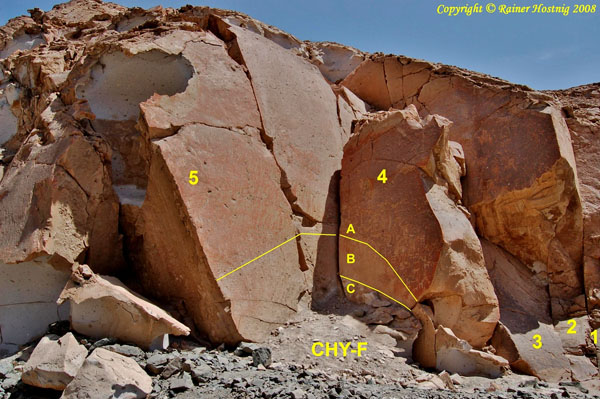 |
Figure
7. Sector CHY-F at Chillihuay,
southern Peru, looking SSW.
A very large part of Panel CHY-F-001 is not shown
in the photo.
Photograph © by Rainer Hostnig (2008). The information on the
photo has been added by the author.
|
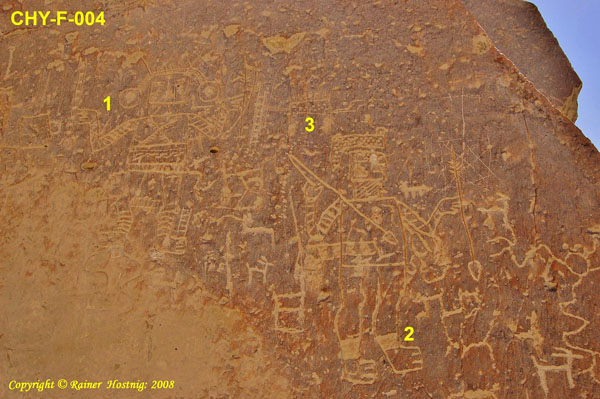 |
Figure
8. Panel CHY-F-004 of Sector
CHY-F at Chillihuay, southern Peru.
Photograph © by Rainer Hostnig (2008). Not
the complete panel is shown here.
The information on the photo has been added
by the author.
|
Most important in view of
this paper, however, is petroglyph panel CHY-F-004 (Figure 8), which now may
also be regarded as a boulder once detached from the cliff. Importantly, panel
CHY-F-004, which is almost vertical, faces roughly east and thus it is the
first panel that any person approaching from the San Juan de Chorunga
petroglyph field would see. Visible from Sector CHY-F and below the horizon is
the top of Cerro Iquipí, 5.7 km to the west.
Panel CHY-F-004 houses a
large collection of larger and smaller petroglyphs but also the two huge,
authoritative anthropomorphic figures that Chumpitaz Llerena and Rodriguez Cerrón (2014) have
called The Lord (El Señor)
and The Warrior (El Guerrero). It is
certain that the markings on this panel are from different periods. For
instance, I think that the simple, ‘match-stick’ depictions of small quadrupeds
(most likely to represent camelids) are fairly young; they even possibly date
from Inca times (or later). The two (perhaps three) lightly scratched Christian
cross-on-altar designs partially superimposing the Lord and the Warrior seem to
be rather recently made petroglyphs (most likely they are Post-Colonial). Many
of the ‘random’ (linear) scratches (the latter often found within several
petroglyph grooves apparently made in order to ‘enhance’ the layout) and some
other graffiti may even be regarded as evidence of (recent!?) vandalism. It
will remain a matter of discussion what age the Lord and the Warrior are, but
they are certainly Pre-Columbian. The age of several other markings, like the
finely incised zigzags, is hard to determine.
Not all petroglyphs on this
panel are clearly visible. Area A of panel CHY-F-004 (see Figure 7) is fully
exposed, deeply patinated and shows most petroglyphs and other markings very
clearly. The petroglyphs in Area B are more blurred, as this area, showing a
more yellowish colour, seems to have been affected/weathered more. It is
possible that some time a pile of rubble covered this area (similar areas occur
on adjacent panel CHY-F-005. Area C probably has been covered for a longer time
and seems to have no petroglyphs. Chumpitaz Llerena and Rodriguez Cerrón (2014)
suggest that the Lord was manufactured at a higher level than the Warrior in
order to establish its supremacy over the Warrior. This may be true, but it is
equally possible that the difference in position is simply explained by the
possibility that the sloping layer of debris that once covered Areas B and C of
the panel enabled the Lord to be manufactured at a higher point, while the
Warrior was manufactured (later?) at a lower level.
Before describing the Lord (Petroglyph 1 in Figure 8) and the
Warrior (Petroglyph 2 in Figure 8) in more detail, I would like to draw the
attention to the petroglyph of an apparent headdress in-between the Lord and
the Warrior (Petroglyph 3 in Figure 8). It is an isolated design, basically
similar to an isolated petroglyph on a petroglyph panel at Alto de Pitis (see
Figure 1 for the location), although the example on panel CHY-F-004 shows more
detail and has a row of short lines emerging from the upper part (Van Hoek
2013: Fig. 87). Interestingly, the isolated profile design is similar to the
profile headdress hovering over the head of the Warrior. It may represent an
earlier attempt to start the manufacture of the Warrior at a position closer to
the Lord. It is also possible that the profile headdress hovering over the head
of the Warrior is a later (Wari?) addition.
Another design further to the left on the same panel (not
visible in Figure 8) might represent a head or mask. It is crowned by two
stepped designs facing away from each other. Although it seems to have two
(closed) eyes and one large open mouth (without teeth), it also seems to show a
nose at each side of the head.
2: The Lord
The larger of the two
anthropomorphic figures, the Lord (Figure 9A), measures 87 cm in height,
including the whole crown and the ‘high heel’ (measurements are based on
photographs by Rainer Hostnig, but are my responsibility). The figure has been
fully frontally depicted (except for the legs and the feet) in a typical ‘Staff
God’ position (Van Hoek 2011: Fig. 164; 2013: Fig. 89). The fingers of its left
hand ‘hold’ (rather, touch) two spears, one straight, one curved and both with
feathers, while the fingers of the right hand ‘hold’ (touch) a ladder design,
which may represent the throwing device of an atl-atl. It is uncertain if a
ladder design next to the spears is also associated with the Lord. There are
namely two other randomly placed ladder designs near the legs of the Lord and
another ‘inside’ (superimposing? - superimposed by?) the Warrior (those
‘ladder’ designs are not shown in Figures 9A and 10). The body and the arms and
the lower part of the legs of the Lord are sophisticatedly decorated. So far
the description of the figure by Chumpitaz Llerena and Rodriguez Cerrón (2014) is
correct.
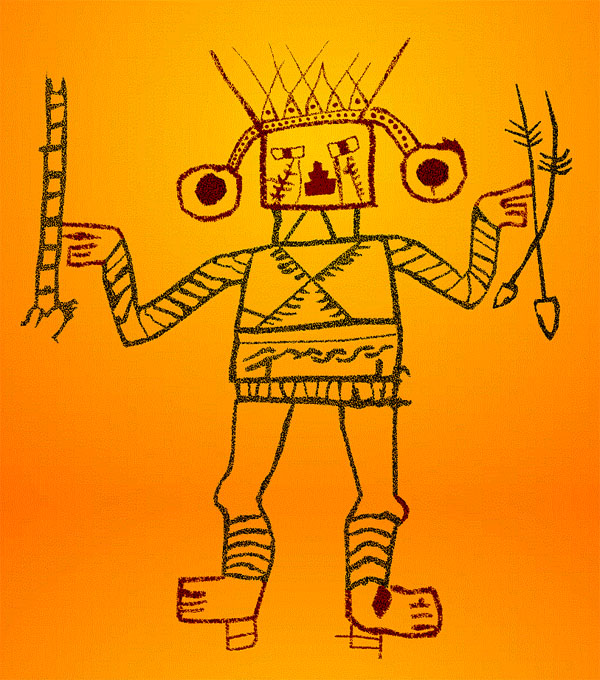 |
Figure
9A. Drawing of the Lord
petroglyph at Chillihuay, southern Peru.
Drawing © by Maarten van Hoek, based
on several photographs from the private photographic
collection of Rainer
Hostnig (2008). However, any inaccuracy is still my responsibility.
|
However, there are several
imperfections in their drawings. Some are minor; others are crucial, especially
when it comes to interpreting and dating. Minor discrepancies concern the
details of the legs and arms; more specifically: the hands and the left foot. Chumpitaz Llerena and Rodriguez Cerrón (2014) draw
the (five) fingers of both hands and the (five) toes of the left foot as simple
straight lines with open ends, while in fact all (three or four?) digits are
closed-in (like the toes of the right foot) or touch the devices they hold. The
knee-cap of the left leg is also much more prominent. Finally, the Lord’s feet
seem to have “high heels’; the right foot ‘standing’ on two rectangular and
outlined elements, the left foot ‘standing’ on one such element, but it is not
certain if indeed those elements were part of the initial figure.
The head (Figure 9B) is
literally crowned by a crown showing many fine details (partially superimposed
by a Post-Colonial Christian cross-on-altar petroglyph), with two large dotted
appendages terminating in a large circle with a large and shallow depression at
each centre, thus not ending in two simple concentric circles as suggested by Chumpitaz Llerena and Rodriguez Cerrón (2014).
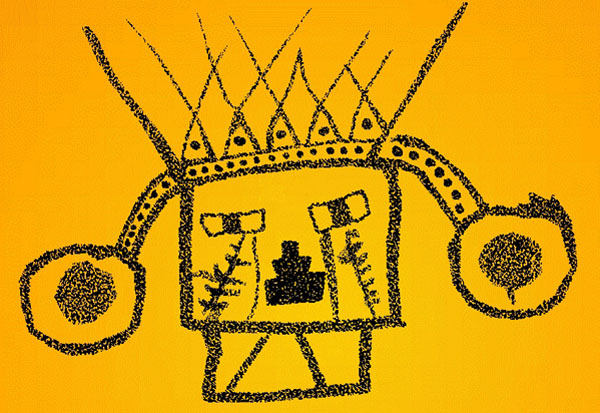 |
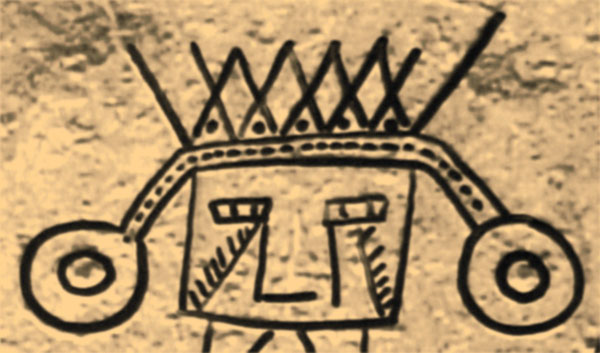 |
Figure
9B. Top: Detail of the head of
the Lord petroglyph, Chillihuay, southern Peru.
Drawing © by Maarten van Hoek, based on several photographs from the private
photographic
collection of Rainer Hostnig (2008). However, any inaccuracy is
still my responsibility.
Bottom: Detail of the head of the Lord
petroglyph according to Chumpitaz Llerena and
Rodriguez Cerrón (2014), digitally enhanced by the author.
|
The more disturbing
discrepancies all involve the facial features within the rectangular head (also
crossed by thin grooves possibly representing a Post-Colonial Christian
cross-on-altar petroglyph) (Figure 9B). The first disagreement concerns the
eyes. Chumpitaz Llerena and Rodriguez Cerrón (2014) describe the eyes as follows: ‘Los ojos de forma rectangular presentan pupila centralizada’, and draw the eyes and the pupils as outlined rectangular elements, while in fact the centrally placed
pupil is a fully pecked square, thus forming the specific rectangular, tripartite eyes. Tellingly, this tripartite eye
motif is repeated in the most complex MSC-Style ‘face’ petroglyph on Panel
CHY-F-005 (Van Hoek 2011: Fig. 120A; 2013: Fig. 90), which is directly facing
panel CHY-F-004. Chumpitaz Llerena and Rodriguez Cerrón (2014) seem
to suggest a Wari origin for the Lord and the Warrior. However, tri-partite
eyes are frequently found in Paracas iconography, but are virtually absent in
Wari iconography.
Secondly, Chumpitaz Llerena and Rodriguez Cerrón (2014)
describe the two diagonal lines that run from each eye and suggest that those
lines represent facial painting (which is, of course, possible). They draw the
two diagonal lines with short lines emerging only from one side of the line. However, the line from the right
eye has short grooves at both sides
of the line, while the other line has what seems to be a damaged area what
could have been an attempt to create a similar second row of short grooves.
Most troubling is the ‘nose’
that Chumpitaz Llerena and Rodriguez Cerrón (2014) do not describe or mention in their
text. Yet they seem to have drawn a ‘nose’ by indicating two straight lines
(one vertical; one horizontal). However, the factual layout is much more
complex (Figure 9B). The vertical line that Chumpitaz Llerena and Rodriguez Cerrón (2014) draw actually represents a groove that runs from near the right
eye to the chin line. A similar groove runs from the left eye to the chin line.
Yet, those two lines have nothing to do with a ‘nose’ feature.
However, centrally placed
between those two straight, vertical grooves is a striking element that,
surprisingly, has completely been ignored by Chumpitaz Llerena and Rodriguez Cerrón (although it
is faintly visible in their photos). It is a fully pecked, double-stepped
pattern; an archetypal Andean design. Across the stepped pattern runs a
vertical groove that is traversed by a short horizontal line above the stepped
pattern (like a Christian cross). This vertical line plus short the horizontal
groove and other grooves probably are part of an Early Christian cross (not
shown in Figure 9). The stepped element may represent the nose, but it is
equally possible that it combines the nose and the mouth (which seems to be absent otherwise). An anthropomorphic petroglyph
with a strange element that seems to combine a nose and a mouth is found on
panel Bg-027 at Toro Muerto.
3: The Warrior
Although Chumpitaz Llerena and Rodriguez Cerrón (2014) argue
that the Warrior is the bigger of the two anthropomorphic figures, the Warrior
(81 cm in height) is in fact slightly smaller. It may be possible that the
Warrior (Van Hoek 2013: Fig. 88), who is ‘overlooking’ the path in the dry
valley, is actually laterally depicted; only the arms (and possibly the thorax)
are positioned as being viewed frontally. In its left hand it ‘holds’ (touches)
a spear with outlined spear head, while the other hand clearly ‘holds’
(touches) a spear-thrower (atl-atl) with a similar spear attached. Thus, the
Warrior has been depicted in an active position, as if he is throwing a spear,
like a warrior or a hunter (ignoring the downward pointing direction of the
spear). The almost square head is crowned by a ‘floating’ profile-headdress
randomly filled with small dots. So far the description of the figure by Chumpitaz Llerena and Rodriguez Cerrón (2014) is correct.
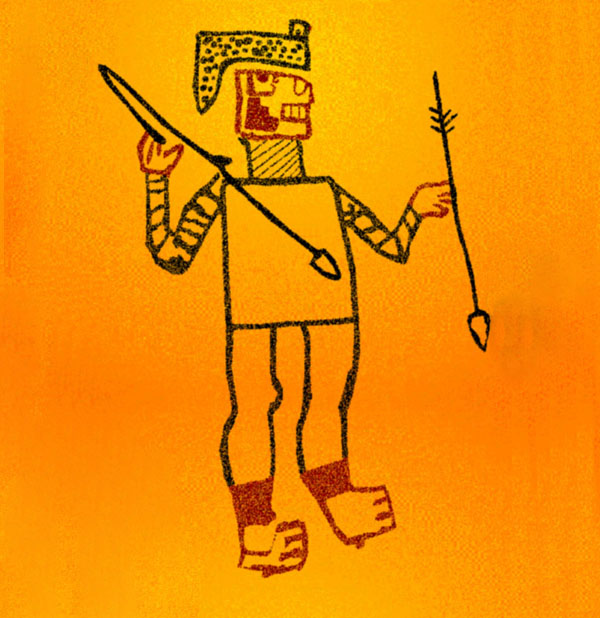 |
Figure
10. Drawing of the (partially
reconstructed) Warrior petroglyph at Chillihuay, southern Peru. Drawing © by
Maarten van Hoek, based on photographs from the private photographic collection
of Rainer Hostnig (2008). However, any inaccuracy is still my responsibility.
|
There are, again, minor and
major discrepancies. The profile head seems to have a rectangular, grinning
mouth possibly showing three rectangular teeth, whereas Chumpitaz Llerena and Rodriguez Cerrón (2014)
indicate the mouth with one simple straight and horizontal line. The area of
the mouth and the area above are rather blurred by weathering and it seems that
the nose is not as prominent as drawn by Chumpitaz Llerena and Rodriguez Cerrón (2014). Moreover, above the mouth, attached to the upper horizontal line
of the head, is a small, curved groove (or circular element) that may represent
a nostril. To the left of this purported nostril is a possible rectangular eye
with a questionable eccentrically pupil, the whole (eye and ‘pupil’) also
placed against the upper horizontal line of the head. Below the eye is not an
outlined, but a fully pecked cheek-element in the form of a single-unit stepped
design. Similarly, Chumpitaz Llerena and Rodriguez Cerrón (2014) draw
outlined ankles, while those areas comprise clearly fully pecked areas. And,
like with the Lord, Chumpitaz Llerena and Rodriguez Cerrón (2014) draw
the (four) toes of both feet as simple straight lines with open ends, while in
fact all (three or four?) digits are clearly closed-in by a vertical groove.
Similarly, all fingers have closed ends and are not shown as simple straight
lines.
Discussion
One question that
immediately springs to mind when reading the discrepancies in the descriptions
of those anthropomorphic figures is: are such details as described above
important? Yes, they are! I can present several instances where inaccurate or
incorrect drawings of Andean rock art images have lead to completely false
interpretations, but that is not the intention of this paper. Any sincere rock
art scientist will admit that it is only possible to present a consistent and
constructive interpretation upon illustrations that do not show inaccuracies
similar to those described above. Moreover, future researchers may use the
drawings by Chumpitaz Llerena and Rodriguez Cerrón (2014) taking them for granted and then may
start their reasoning upon inaccurate drawings and/or copy them. The following
discussion, in which the graphical details are decisive, mainly focuses on the
issue of chronology of the Shaman, the Lord and the Warrior.
The Chronology of the Shaman, the Lord and the Warrior
Chumpitaz Llerena and Rodriguez Cerrón (2014) argue that the images of Cerro Chillihuay date back from the
Formative Period to the Middle Horizon. They claim that images from later
periods - such as the Late Intermediate Period or the Late Horizon Period
(Inca) - have not been identified by them. I challenge this claim. For instance,
contradicting their statement are the incised Early Christian cross-on-altar
petroglyphs on panel CHY-F-004 (which definitely are not instances of
vandalism). Moreover, I would like to suggest that especially the simpler
representations of quadrupeds (probably representing camelids) may well be
Post-Middle Horizon. As no-one ever dated any of the petroglyphs at Chillihuay,
nothing can be said about the absolute dating of the images. At the moment the
only tool available is looking for analogies.
Although I principally agree with Chumpitaz Llerena and Rodriguez Cerrón (2014) that the Shaman petroglyph dates from the Pre-Chavín (Formative) Period, their dating-claim needs
further refinement. Chumpitaz Llerena and Rodriguez Cerrón notably base their dating on ‘the eccentric’
eye, the ‘agnatic’ mouth, the interlocking fangs of the ‘feline’, the
triangular loincloth and the
belt of the Shaman (2014: Los
primero rasgos prechavines van conformándose en estas representaciones: el ojo
excéntrico, la boca agnática, los dientes de felino a posiciones contrapuestas,
así como las pampanillas, el cinturón que cuelga alrededor del personaje).
However, there are some conflicting observations in
this statement. First of all the Shaman has no eccentric eye (in my opinion the Shaman even has no eyes).
Moreover, in this respect Chumpitaz Llerena and Rodriguez Cerrón (2014)
contradict themselves in one of the captions in their paper where they describe
the eye of the Shaman as ‘ojo con pupila centralizada’. Secondly, I have demonstrated that there
is no agnatic mouth; only teeth of both the upper and lower jaws. Even
the triangular loincloth and the
possible snake-belt are doubtful elements from the Formative Period (but take
into account my observations elsewhere in this paper). It thus seems that only the typical MSC-Style
teeth-fangs-combination of the Shaman may confirm a Formative Period dating.
Yet, I as well am convinced that the whole figure is of Formative Period
origin.
Now it is the case to determine the origin of the
interlocking fangs. These fangs may have been a local invention or the element
is foreign. If the latter possibility is the case, they may have been borrowed
from the Paracas or even the Manchay iconography. Although Chumpitaz Llerena and Rodriguez Cerrón claim that they have
registered numerous Formative (Paracas) images at Chillihuay (2014: En los petroglifos de Chillihuay hemos registrado un número muy alto de iconografía formativa [Paracas]) they offer no illustrations or
descriptions of those Formative (Paracas) images (for a number of illustrations
of such Formative Period petroglyphs see Van Hoek 2011). Also, they do not
refer to earlier published works. Interestingly
though, they noticed the absence of any Formative Period ceramic remains in the
whole of this stretch of the Chorunga valley (a diferencia de la nula presencia de cerámica formativa en toda esta quebrada). Although this purported absence seems
to confirm a local invention of the MSC-Style elements, I still suggest that
the MSC-Style was more likely borrowed from the coastal Paracas and/or Manchay
cultures further NW.
Having said that, I moreover argue that the chronology
of the Shaman may even be more complex. I have learned
always to doubt that a complex figure or a complex petroglyph panel is
exclusively the product of one culture or of one person, as (parts
of) images may have been added and/or altered by subsequent cultures. This may
also apply to the Shaman (and possibly to the Lord and Warrior as well).
The Shaman actually comprises three isolated elements: the mouth and the
headdress, the arms and the shoulder-lines, and the belt with loincloth and
legs. I now argue that possibly the
mouth of the Shaman was the very first element to be manufactured (perhaps
together with the purported ‘nose’ element). An argument in favour of this
hypothesis is that at the Chillihuay complex (and at many other MSC-Style
petroglyph sites) several isolated MSC-Style mouth or ‘face’ and head petroglyphs are found (Van Hoek 2011).
Especially the large ‘mouth’ with fangs and one eccentric eye on panel CHY-D-015B is telling.
Furthermore, several isolated head petroglyphs occur at
Chillihuay (Van Hoek 2013: Fig. 28). One such head, on panel CHY-D-005, is
informative. Apparently the outlined head - with a neck stump? - seems to be
floating above a pair of legs, while there is no body and no arms (also compare
this with a Paracas human figure with a separated/severed head with neck stump
[Frame 2001: Fig. 4.7.C]). Another isolated head petroglyph, on panel
CHY-E-001, has two curved rows of dots descending from the neck area.
Interestingly, similar dots in Nasca iconography are regarded to represent
drops of blood (Proulx 2001: 128).
At some time a head or headdress in the form of angular
serpentine grooves may have been added. Interestingly, isolated grooves similar
to the headgear of the Shaman also occur on panel CHY-B-007 at Chillihuay and
on a big boulder at San Juan de Chorunga. Similar angular serpentine grooves
have also been recorded at sites in the Caravelí drainage and in the Manga
drainage, but also at Toro Muerto in Majes, for instance on panel Da-012.
At the same time, or later still, the arms and
shoulder-lines, may have been added, thus creating a head (or mouth) ‘floating’
above a pair of arms. A similar situation is found on panel CHY-D-005 where an
isolated head/neck petroglyph hovers over a pair of legs (arms?). Much later
the loincloth and legs may have been added resulting in the ‘complete’
anthropomorphic figure of the Shaman. Especially the legs seem to offer another
clue to have been added (much) later, that is, only if Chumpitaz Llerena and Rodriguez Cerrón (2014) are correct in assuming that the Lord and the Warrior are of
Middle Horizon (Wari) manufacture. It is namely remarkable that the legs of the
Shaman (exhibiting rather clearly the knees and the calves) are much similar to
the legs of the Lord and especially the Warrior. This may imply that either the
legs (of the Shaman, the Lord and the Warrior) are of the same (Middle Horizon?)
date, or, conversely and even more likely, that the Lord and the Warrior and
also the complete figure of the Shaman are also of Formative Period
manufacture; the Shaman possibly being manufactured in several stages during
the Formative Period.
Interesting in this respect
are the eyes of the Lord that are clearly tripartite. Importantly, they are
similar to the eyes of the complex Formative Period MSC-Style ‘face’ petroglyph
of adjacent panel CHY-F-005. Attached to the mouth of this ‘face’ petroglyph is a
large outlined triangle (Van Hoek 2011: Fig. 120A), which is similar
to the (loincloth) triangle of the Shaman. This feature also seems to confirm
that the whole of the Shaman petroglyph is of Formative Period. Even more
surprising is the occurrence of tripartite eyes on an MSC-Style anthropomorphic
ceramic from (probably) Jequetepeque in the north of Peru (Van Hoek 2011:
Fig. 120B). Yet I am convinced that the origins of the Chillihuay tripartite eyes
must be sought in the Paracas iconography that originated on central coastal
area of Peru.
Indeed, several
complex Paracas (textile) figures often display such rectangular tripartite eyes in various formats and layouts (Frame 2001: for
instance Figs 4.6.A and D, 4.8.C, 4.9.D). Confirming the Paracas link even more
is the fully pecked stepped element of the Lord’s face, which possibly
symbolises a mouth-nose combination. In my opinion the element is definitely
related to the stepped mouth design in the faces of Paracas textile figures
(Frame 2001: Figs 4.7.C and 4.10.A). This type of stepped mouth-nose
combination seems to have occasionally been borrowed by the Nasca from Paracas
as well (Clados 2009: Number
217).
In fact, the Lord-petroglyph
of Chillihuay seems to be a more simplified version of the complex Paracas
skirted figure illustrated by Mary Frame (2001: Fig. 4.10.C). This Paracas
textile figure (Figure 11) has been depicted in the same frontal (‘Staff God’)
position and is holding objects in each hand (notice that the object in the
left hand is somewhat similar to the ladder design at Chillihuay). Moreover,
the figure has tripartite eyes, wears a sophisticated crown, has a grinning
mouth within a stepped element; wears
a skirt which has a belt. The figure is clearly associated with snake symbolism
(like the Shaman). Finally it has two laterally depicted legs showing knees and
calves with decoration around the ankles and it has feet similar to the Lord.
It seems to have been a typical Paracas convention to depict anthropomorphic
(and most zoomorphic) images with frontally depicted heads and laterally
depicted legs and feet. Although depictions of the feet in Nasca iconography
are often similar, the legs in Paracas figures are often much longer. In this
respect Paracas legs resemble more the legs of the Shaman, the Lord and the
Warrior.
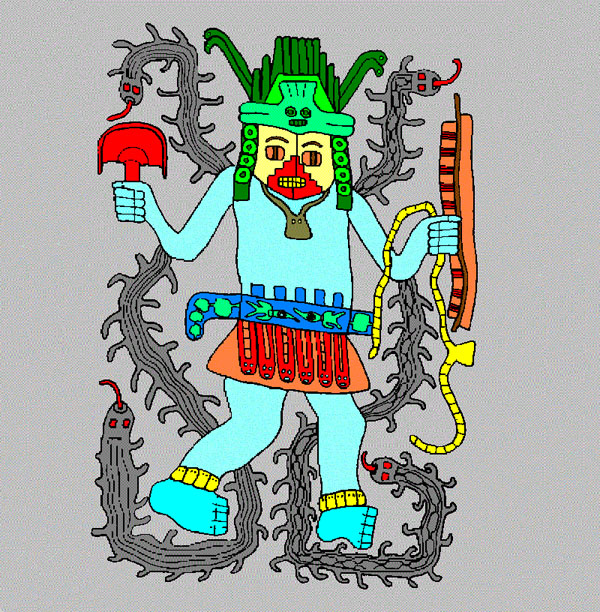 |
| Figure
11. Drawing of a Paracas textile from southern Peru. Drawing ©
by Maarten van Hoek, based on a drawing by Mary Frame (2001: Fig. 4.10.C).
However, any inaccuracy or misinterpretation still is my responsibility. The
colours only serve to represent a clear picture.
|
However, despite the
obvious Paracas influence, I argue
that the Lord petroglyph more likely
is of local manufacture. With this I mean that I think that the local
‘Chorunga’ people manufactured the image possibly after having seen a Paracas
figure, for instance on an imported textile. One possible indication for a
local manufacture is the pattern of diagonal (X) lines on the thorax, which, as
far as I could check, is absent in Paracas anthropomorphic figures.
Still, several, much
simpler anthropomorphic petroglyphs at Chillihuay display the same X-pattern on
the thorax. Two petroglyphs on (rotated?) boulder CHY-B-015 seem to represent either simplified human
figures or isolated tunics; both displaying an X within the outlined frame of
the ‘thorax’ (or tunic). An anthropomorphic petroglyph, on panel CHY-D-026, has
an object in its right hand and also an X on the thorax. The lines of this X
seem to have short side-lines, similar to the X on the thorax of the Lord.
Also, from the (purported) eyes of the figure run two grooves to the chin area
and also those lines seem to have similar short side-grooves. On Panel
CHY-A-007 are two anthropomorphic petroglyphs both with an X on the thorax. One
figure has no arms and has a large circle with central dot depicting the head.
The other figure has an object (one short, straight line) in its right hand
that may represent a spearthrower (the throwing
device - estólica),
while the left hand seems to hold a bundle of objects (three short, parallel,
straight grooves) that may represent the throwing-spears (dardos). This figure may be
compared with Motif 9 on Panel 5 of the Cueva de Pumawasi rock painting site in the Province of Anta, Cusco, eastern Peru, (Hostnig 2014: Fig. 32ab).
A very simple example of an anthropomorphic figure with
an X-pattern on the thorax has been reported on a boulder in the Caravelí
Valley, west of Chillihuay. Yet the X-pattern has a much wider distribution
and, surprisingly, it seems to have a more oriental orientation. Two
anthropomorphic figures with an X on the thorax (but both with both arms raised
and empty hands) have been reported on at least two panels (PAJ-008 and
PAJ-014) at Illomas, further east. Petroglyphs of anthropomorphic figures with
an X on the thorax have also been recorded on boulders at Toro Muerto (one
including a flute-player petroglyph with an X-pattern) and at Alto de Pitis,
both in Majes and again further east. And about 150 km to the ESE of
Chillihuay, in the valley of the Río Vitór/Chili, is a boulder with an
outlined, fully frontally depicted anthropomorphic petroglyph featuring an
X-pattern on its body. The X also has short side-grooves, which creates an
arrangement that is almost identical to the X-pattern on the Lord’s chest. A
similar X-pattern (again with short side-grooves) on the body of an
anthropomorphic petroglyph has been reported on a boulder in the valley of the
Río Tambo, 200 km SE of Chillihuay.
Tellingly however, in the Paracas-Nasca cultural
region, far to the west of Chillihuay, anthropomorphic petroglyphs with an X on
the thorax are very rare. Examples have to my knowledge only been reported at
La Viuda in the Palpa Valley (a completely different
instance, though) and at Huancano in the Pisco Valley
(Núñez Jiménez 1986: Figs 1903 and 1905). A large, much weathered
anthropomorphic petroglyph in the Ingenio Valley may
have an X on the lower part of the body, but unfortunately an accurate
description/illustration of this (Paracas?) petroglyph has not (yet?) been
published.
Although Chumpitaz Llerena and Rodriguez Cerrón (2014) speak
of ‘arrows’ (‘flechas’)
when describing the objects held by the Warrior, it is more likely that the
(outlined) pointed linear objects associated with the Warrior are spears used
in an atlatl (which the Warrior ‘holds’ in his right hand); not arrows of a bow-and-arrow. I
also argue that, likewise, the (outlined) pointed objects associated with the
Lord are spears used in an atlatl, not arrows, despite the fact that it is uncertain
whether the ‘ladder’ object represents a throwing device. A Paracas textile
figure (Frame 2001: Fig. 4.7.A) seems to hold two spears depicting spearheads
and feathers; an indication that the Paracas (and also the later Nasca) used
the throwing spear device (the atlatl) for hunting and warfare. In this respect it must be
mentioned that the bow-and-arrow was probably introduced into this part of the
Andes for the first time during the late Middle Horizon (probably by the Wari).
In this respect I would like to discuss again the
specific spatial position of the Lord and the Warrior. In my opinion both
orientation and location of the two large figures are highly intentional. Panel
CHY-F-004 typically faces east and everyone approaching from the east would
have first noticed the large, menacing figures of the Lord and the Warrior.
Their aspect would be particularly noticeable in the early days, because of the
strong contrast of the freshly made, white figures against the dark, patinated
background of the panel. I therefore argue that the Lord and (especially) the
Warrior may have served as territorial markers or as warning signs for the
uninvited or the uninitiated. Parallels of such possible marker-petroglyphs are
found in the north of Peru, for instance the large bird petroglyph situated in
an important pass of Cerro Saltur, the huge anthropomorphic head (plus large tumi) petroglyph at Pampa Grande, both
in Lambayeque (Van Hoek 2014), and the ‘Guerreros Danzantes’ at Alto de la Guitarra in the Virú drainage.
It is however a possibility that the Warrior is a later
addition. The fact that the figure has been depicted in profile may point to a
later origin. Prof. Donald Proulx (2001: 125; my additions) notably argues that
‘Front-facing warriors are most prevalent
in the early Nasca phases (thus possibly continuing the existing Paracas
conventions), but by Middle Nasca times
they are depicted in profile (possibly a Wari influence). Representations of weapons, especially
spears, but also bloody clubs, become more numerous in Middle Nasca (Phase 5),
and one could argue for an increase in warfare at this time (which coincidentally
correlates with periods of drought and subsequent relocation of people within
the tributaries of the Rio Grande de Nasca dating to A.D. 540 to 610)’.
This analysis may suggest that also the weapons of the Lord petroglyph were
added at a later phase and that, initially, the Lord may have initially been
intended to represent a (more welcoming?) variation of the ‘Staff God’ (Van
Hoek 2011: 185-189).
The Geographical Context
Again
I refer to the fact that Chumpitaz Llerena and Rodriguez Cerrón (2014) rightly argue that Chillihuay houses a large
number of Formative Period (Paracas) images. Unfortunately they do not specify
which images they refer to. Indeed, Chillihuay has a surprisingly, but only
relatively speaking, high number of definite Formative Period MSC-Style images.
No less than six MSC-Style anthropomorphic petroglyphs (mainly heads or
partially depicted facial features) have been reported at Chillihuay so far.
This number is exceptionally high in view of the scarcity of MSC-Style images in
the whole of southern Peru. Until 2011 only three other sites had been reported in the coastal strip south of Lima: Huancor,
Chichitarra and Bogotalla, each with only one MSC-Style image, as far as I know
(Van Hoek 2011). To date, in 2014, a fifth site in the south of Peru, thus not
Chillihuay, has been reported to have several definite MSC-Style petroglyphs.
It seems that Chumpitaz Llerena and Rodriguez Cerrón were not aware of those new finds.
Finally, it is strange
that Chumpitaz Llerena and Rodriguez Cerrón (2014)
look at Toro Muerto as the site with
related imagery: Existe mucha similitud y
“hermandad” tanto en la técnica usado en el grabado, simbología y cosmovisión
y, los períodos cronológicos en el uso de estos espacios entre los petroglifos
de Chillihuay y Toro Muerto. Indeed, some petroglyphs at Chillihuay seem to be (often
distantly) related to the Majes Rock Art Style at Toro Muerto, but definitely
not the majority. Moreover, to my knowledge (Van Hoek 2013), Toro Muerto does
not have a single MSC-Style anthropomorphic (head or facial feature) petroglyph
and, moreover, only an extremely low number of images that have possibly been
borrowed from the Paracas iconography.
Conclusions
A part of the subtitle of the paper by Chumpitaz Llerena and Rodriguez Cerrón (2014 del formativo al período de integración Wari) seems to suggest that they
assign the Shaman to the Formative Period origin while simultaneously they
suggest that the Lord and the Warrior are of Middle Horizon manufacture. In the
current paper I have demonstrated that their chronology is questionable. The
Shaman displays a possible Paracas or Manchay MSC-Style mouth and Paracas legs
and feet and may indeed be a Formative Period petroglyph. On the other hand,
the Lord exhibits a Paracas mouth, Paracas legs and feet, the tripartite
Paracas eyes and an attitude similar to Paracas figures. Therefore the Lord as
well may be of Formative Period origin. The Warrior displays Paracas legs and
feet, but it also displays an attitude that may show late Nasca influence. The
profile headdress hovering over the head of the Warrior may be an even later
(Wari?) addition. Therefore, the exact chronologies of the Shaman, the Lord and
the Warrior are still uncertain and will have to be confirmed by more solid evidence.
But it is certain that any attempt at establishing a chronology must be based
on accurate renderings of the petroglyphs in question.
Acknowledgements
As ever I am indebted
to Rainer Hostnig, rock art researcher from Cusco,
Peru, for sharing with me his valuable photographic collection of Chillihuay
rock art, granting me permission to use and publish his photographs and for
providing much additional information about Chillihuay and other rock art
sites. I am also indebted to Dr. Renata Faron-Bartels who helped me with information regarding the
Illomas petroglyph site.

Cómo citar este artículo:
van Hoek, Maarten. The shaman, the lord and the warrior:
anthropomorphic petroglyphs at
Chillihuay, Arequipa, Peru.
En Rupestreweb, http://www.rupestreweb.info/shamanchilliguay.html
2014
REFERENCIAS
(The underlined blue references are hyperlinks as
accessible in 2014)
Chumpitaz Llerena, D. 2006. Lenta
agonía de los Petroglifos de Chillihuay. Arequipa. Perú. In: Rupestreweb Mensajes.
Chumpitaz Llerena, D. 2007.
RV: Lenta
agonía de los Petroglifos de Chillihuay. Arequipa. Perú. In: Rupestreweb Mensajes.
Chumpitaz Llerena, D. 2009. Tercer Ciclo de
Conferencias en Arte Rupestre - APAR / INC - Tacna. In: Rupestreweb Mensajes.
Chumpitaz Llerena, D. and M. Rodríguez Cerrón. 2013. “Los petroglifos de
Chillihuay: la imagen antropomorfa (del Formativo al periodo de integración
Wari)”. V SINAR - “Eloy Linares Málaga”. Museo de Arqueología y Antropología,
Universidad Nacional Mayor de San Marcos. Lima, Perú.
Chumpitaz Llerena, D. and M. Rodríguez Cerrón. 2014. Los Petroglifos de Chillihuay: La
imagen antropomorfa (del formativo al período de
integración Wari). In: Rupestreweb.
Clados, C. 2009. Nasca Drawings Collection. Famsi Resources.
Frame, M. 2001. Blood, Fertility, and Transformation:
Interwoven Themes in the Paracas Necropolis Embroideries. In: Ritual
Sacrifice in Ancient Peru. Eds. Elizabeth P.
Benson and Anita G. Cook. Chapter 4: pp 55 - 92. University of Texas Press, Austin.
Hostnig, R. 2003. Arte rupestre del Perú. Inventario Nacional. CONCYTEC, Lima, Perú.
Hostnig, R. 2014. Chinchaypucyo y las pinturas
rupestres de Pumawasi, provincia de Anta, Cusco. In: Rupestreweb.
Linares Málaga, E. 1973. Anotaciones sobre las cuatro
modalidades de arte rupestre en Arequipa (pictografías, petroglifos, arte
rupestre mobiliar y geoglifos). In: Anales
Cientificos de la Universidad del Centro del Perú. Corrected version in: Boletín APAR. 2013. Vol. 4, No 15-16.
Linares Málaga, E. 1991-1992. Prehistoria
de Arequipa. Vol. 2. Arequipa.
Linares Málaga, E. 2004. Arte rupestre en Arequipa y el sur del Perú. Editorial Nuevo
Milenio. Arequipa.
Núñez Jiménez, A. 1986. Petroglifos
del Perú. Panorama mundial del arte rupestre. 2da. Ed. PNUD-UNESCO –
Proyecto Regional de Patrimonio Cultural y Desarrollo, La Habana, Cuba.
Paz de Noboa, C. A. 1940. Pajgchana, su
cementerio y sus petroglifos. Actas y
trabajos scientificas del XXVII Congreso Internacional de Americanistas. Tomo 1; pp 531 - 544. Lima.
Perú Explorer. 2006. Chillihuay. Revista Perú Explorer, Nº 3.
Proulx, D. A. 2001. Ritual Uses of Trophy Heads in Ancient Nasca Society. Chapter 6; pp 119 - 136. In: Ritual
Sacrifice in Ancient Peru. Editors: Elizabeth P. Benson and Anita G. Cook. University of Texas Press, Austin, Texas, USA.
Rodriguez Cerrón M. and D. Chumpitaz Llerena. 2008.
Los Petroglifos de Chillihuay: Aproximaciones a su interpretación. Paper
presented at the III Simposio Nacional de Arte
Rupestre. Huaraz, Perú.
Trujillo Vera, C. C. 2009. Los Petroglifos de
Chillihuay - San Juan de Chorunga. In: Blogspot.
Van Hoek, M. 2011. The Chavín
Controversy - Rock Art from the Andean Formative Period. Oisterwijk, The Netherlands. Privately published using
the BLURB Creative
Publishing Service.
Van Hoek, M. 2012. Rumimantam Llaqllasaq Wirpuykita: The ‘Cycle
of Life’ in the Rock Art of the Desert Andes. Oisterwijk, The Netherlands. Privately published using
the BLURB Creative
Publishing Service.
Van Hoek, M. 2013. The Carcancha and the Apu. Rock Art of the Death Valley of the Andes. Oisterwijk, The Netherlands. Privately published using the BLURB Creative Publishing
Service. Abstract: The Carcancha and the Apu. Rock
Art in the Death Valley of the Andes. In: Rupestreweb.
Van Hoek, M. 2014. The Tumi-Bearer
of Pampa Grande, Lambayeque, Peru. In: Adoranten -2013; pp 97 - 109.
Underslös, Sweden. PDF available from the author.
|
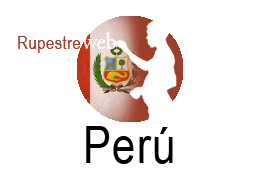













![]()
